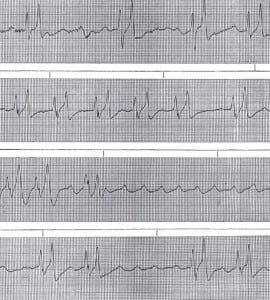| Author | Affiliation |
|---|---|
| Clark Rosenberry, MD | Madigan Army Medical Center, Department of Emergency Medicine, Fort Lewis, WA |
| Franco Stone, NREMT-P | Madigan Army Medical Center, Department of Emergency Medicine, Fort Lewis, WA |
| Kristine Kalbfleisch, MD | Madigan Army Medical Center, Department of Emergency Medicine, Fort Lewis, WA |
A 22-year-old male was brought in by paramedics who found him unresponsive at home surrounded by drug paraphernalia. He had a blood pressure of 84/50 mm Hg; oxygen saturation of 88%; irregular pulse; and Glasgow Coma Scale of 3. His skin was cool, diaphoretic and ashen in color, except for a grossly erythematous right arm. Lab work demonstrated an initial creatine kinase of 5,414 U/L that increased to 165,300 U/L by the next day. His potassium was 8.6 mmol/L.
Hyperkalemia, defined as a potassium level greater than 5.5 mmol/L, is a potentially fatal disorder that occurs in as many as 10% of hospitalized patients.1,2 Causes include rhabdomyolysis, hemolysis, renal failure, acidosis, and medications.2 Cardiac conduction can be impaired, resulting in dysrhythmias. Electrocardiography (ECG) is important because it may be diagnostic and dictate emergent treatment. The first ECG changes seen are shortening of the QT interval, peaked T waves, and ST segment depression, followed by widening of the QRS complex, increased PR interval, and decreased P wave amplitude. Lastly, the P wave disappears and the QRS widens until it resembles a sine wave. Ventricular fibrillation or asystole may follow. Emergent treatment with calcium gluconate or calcium chloride is indicated to stabilize the myocardium if ECG changes are present.2,3 Serial doses of calcium are given until the ECG normalizes.2 Inhaled albuterol, intravenous sodium bicarbonate, and intravenous insulin with glucose should be used to temporarily shift potassium back into cells.3 Furosemide and sodium polystyrene should also be administered to increase the excretion of potassium. Hemodialysis may be required in the setting of renal failure or severe cases. The ultimate treatment goal of hyperkalemia is to identify and correct the underlying etiology.

Footnotes
Supervising Section Editor: Sean Henderson, MD
Submission history: Submitted May 24, 2009; Accepted June 1, 2009
Full text available through open access at http://escholarship.org/uc/uciem_westjem
Address for Correspondence: Clark Rosenberry, MD, Department of Emergency Medicine, Madigan Army Medical Center, Fort Lewis, WA
Email: crosenberry04@jcu.edu
Conflicts of Interest: By the WestJEM article submission agreement, all authors are required to disclose all affiliations, funding sources, and financial or management relationships that could be perceived as potential sources of bias. The authors disclosed none.
REFERENCES
1. Montague BT, Ouellette JR, Buller GK. Retrospective review of the frequency of ECG changes in hyperkalemia. Clin J Am Soc Nephrol. 2008;3:324–30. [PMC free article] [PubMed]
2. Garth D.Hyperkalemia. eMedicine Web site. Available at:http://emedicine.medscape.com/article/766479-overview Accessed May 3, 2009.
3. Weisberg LS, Dellinger RP. Management of severe hyperkalemia. Crit Care Med. 2008;36:3246–51.[PubMed]


